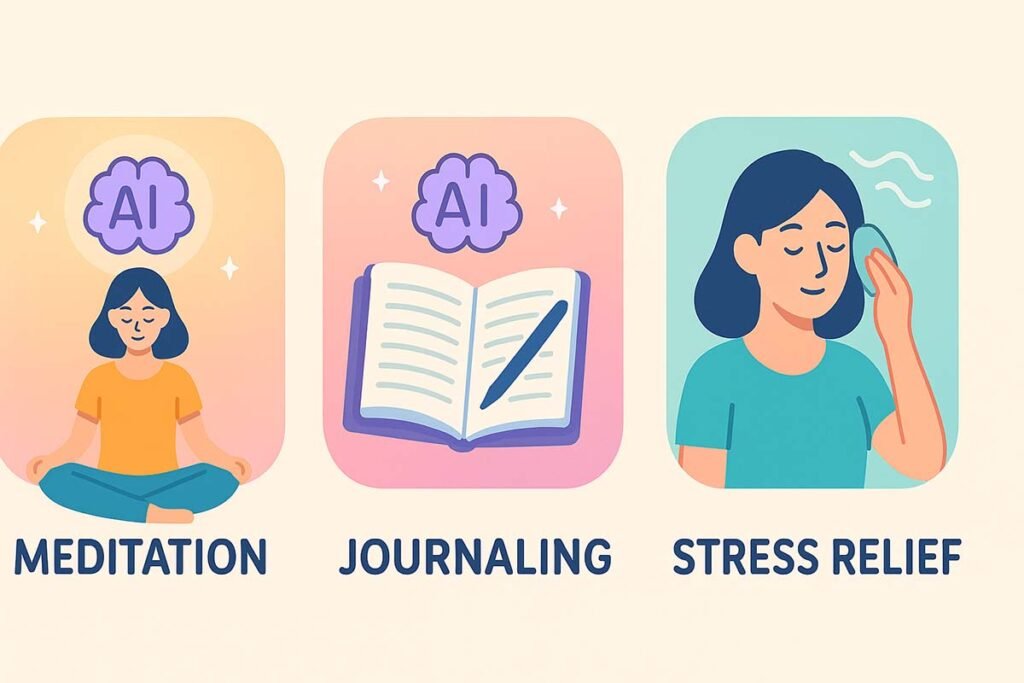Mental health matters more than ever in our fast-paced world. With stress, anxiety, and burnout on the rise, many people seek accessible ways to manage their well-being. Enter artificial intelligence—once a sci-fi dream, now a practical ally in the quest for better mental health. From chatbots that offer instant support to apps tracking mood patterns, AI tools are making wellness more personalized and available around the clock.
But how exactly does this technology help without replacing human therapists? And what are the best options for beginners? In this guide, we’ll explore AI’s role in mental health, spotlight top apps and bots, share real stories, and provide tips to get started safely. Remember, these tools are supportive aids—always consult professionals for serious concerns. Let’s dive into how AI is quietly revolutionizing self-care in 2025.
Understanding AI’s Role in Mental Health
Artificial intelligence in mental health uses algorithms to analyze data, recognize patterns, and provide personalized responses. It’s not about diagnosing or treating conditions—that’s for licensed professionals. Instead, AI acts as a helpful companion, offering coping strategies, mood insights, and gentle reminders.
Key ways AI contributes:
- Data Analysis: Tracks sleep, activity, or journal entries to spot trends like rising stress.
- Conversational Support: Bots simulate empathetic chats, drawing from vast psychological knowledge bases.
- Personalization: Tailors advice based on your inputs, making it feel custom-made.
- Accessibility: Available anytime, anywhere—crucial for those without immediate access to therapists.
In 2025, AI bridges gaps in traditional care, but it’s most effective when paired with human support.
How AI Tools Work for Wellness
AI mental health tools rely on machine learning and natural language processing to understand and respond to users.
Machine Learning Basics
- AI learns from anonymized user data (with consent) to improve suggestions over time.
- For example, if you report high anxiety on weekdays, the tool might suggest evening relaxation routines.
Natural Language Processing (NLP)
- Enables bots to “understand” your words, detect sentiment, and reply conversationally.
- Transitioning from basic chatbots, 2025 versions use advanced NLP for nuanced empathy.
Privacy & Ethics
- Reputable apps use encryption and comply with standards like GDPR.
- Always check privacy policies—good tools never share personal data without permission.
Table: AI vs. Traditional Mental Health Support
| Aspect | AI Tools | Traditional Therapy |
|---|---|---|
| Availability | 24/7, instant | Scheduled sessions |
| Cost | Often free/low-cost | Higher fees |
| Personalization | Data-driven, adaptive | Based on conversations |
| Depth | Surface-level support | In-depth exploration |
| Privacy | Encrypted, app-based | Confidential sessions |
Top AI Apps for Mental Health Support
Mood Trackers & Journals
- Daylio: Tracks moods with simple icons; AI analyzes patterns and suggests coping tips.
- Moodpath: Daily check-ins with AI-generated insights on emotional trends.
Meditation & Mindfulness Guides
- Calm AI Sessions: Personalized guided meditations based on your stress levels.
- Headspace: AI recommends routines after analyzing your sleep and activity data.
Stress & Anxiety Relievers
- Sanvello: Combines journaling, mood tracking, and AI-driven cognitive behavioral techniques.
- Breathe2Relax: Breathing exercises customized by AI to your current heart rate (via phone sensors).
Bullet Points: Why These Apps Stand Out
- Easy integration with wearables like Fitbit.
- Community features for sharing anonymized insights.
- Free versions with premium upgrades for deeper personalization.
Therapy Bots: Your 24/7 Companion
Therapy bots simulate conversations to provide emotional support.
- Woebot: Uses cognitive behavioral therapy (CBT) principles; chats like a friend, offering exercises for anxiety.
- Wysa: Focuses on stress and sleep; AI detects negative patterns and suggests mindfulness breaks.
- Replika: Builds a “digital companion” that evolves with your interactions, helping with loneliness.
Numbered List: How to Use a Therapy Bot Effectively
- Start with honest inputs—bots learn from your responses.
- Set daily check-ins for consistency.
- Combine with journaling for deeper self-reflection.
- If issues persist, seek professional help—bots are supplements, not substitutes.

Wellness Tools Powered by AI
- Sleep Trackers: Apps like Sleep Cycle use AI to analyze patterns and suggest bedtime routines.
- Fitness & Mood Integrators: MyFitnessPal’s AI links nutrition to mood, recommending feel-good meals.
- Virtual Reality (VR) Therapy: Tools like Limbix VR expose users to calming scenarios for phobia management.
Comparison: Free vs. Paid Wellness Tools
| Tool Type | Free Options | Paid Upgrades |
|---|---|---|
| Mood Trackers | Daylio basic | Premium insights ($4.99/mo) |
| Meditation Apps | Insight Timer | Calm premium ($14.99/mo) |
| Therapy Bots | Wysa free chats | Woebot pro modules ($9.99/mo) |
Real-Life Examples & Success Stories
Story 1: Overcoming Anxiety with Wysa
Riya, a college student in Ghaziabad, used Wysa during exam season. The bot’s daily check-ins helped her identify triggers and practice breathing exercises, reducing her anxiety attacks by half. “It felt like having a non-judgmental friend always available,” she shared.
Story 2: Corporate Wellness with Calm
A tech firm in Bangalore integrated Calm’s AI sessions into employee wellness programs. Participation rose 40%, with staff reporting lower burnout. One manager said, “The personalized tracks made mindfulness accessible, even on busy days.”
Case Study: Sanvello in Community Programs
In a 2025 pilot in Uttar Pradesh schools, Sanvello helped 500 students track moods and access coping strategies. Results showed improved focus and fewer reported stress incidents, as per a local health report.
Benefits of AI for Mental Health
- Accessibility: Reaches underserved areas where therapists are scarce.
- Affordability: Many tools are free or low-cost, democratizing support.
- Proactive Monitoring: Spots early signs of distress through pattern recognition.
- Stigma Reduction: Private, judgment-free interactions encourage seeking help.
- Customization: Tailors advice to your lifestyle, culture, and preferences.
Expert Tip: “AI excels at scaling basic support, freeing therapists for complex cases,” notes Dr. Anjali Mehta, a Mumbai psychologist.
Potential Drawbacks & Safety Tips
Drawbacks
- Limited Depth: AI can’t handle crises or deep trauma like humans.
- Data Privacy Risks: Ensure apps follow strict security standards.
- Over-Reliance: May delay seeking real help if not used mindfully.
- Accuracy Issues: Not all suggestions are perfect—AI learns from general data.
Safety Tips
- Use as a supplement, not replacement, for therapy.
- Verify app credentials (e.g., backed by mental health pros).
- Monitor your usage—balance with real-world connections.
Expert Opinions: What Professionals Say
“AI tools like Woebot are game-changers for preventive care, but they thrive when integrated with human therapy.”
— Dr. Vikram Patel, Harvard Mental Health Expert
“Personalized AI wellness plans empower users, but ethical data use is non-negotiable.”
— Priya Singh, AI Ethics Advocate, Delhi
“For young people, these apps build resilience early, turning self-care into a habit.”
— Sarah Johnson, Global Wellness Coach
Getting Started with AI Mental Health Tools
- Assess Your Needs: Journal what you want—stress relief, better sleep, or mood tracking?
- Choose Apps Wisely: Start with highly-rated ones like Wysa or Calm.
- Set Boundaries: Use daily, but limit to 15–30 minutes.
- Track Progress: Note how tools affect your mood over weeks.
- Seek Balance: Combine with exercise, social time, and professional advice if needed.
A Balanced Approach to AI Wellness
AI is quietly reshaping mental health for the better—offering tools that fit into busy lives, provide instant insights, and foster proactive care. From therapy bots easing daily stress to apps building long-term habits, the benefits are real and growing. Yet, remember: Technology supports, but human connection heals.
If you’re ready to explore, download an app today, track your journey, and share what works. Mental health is personal—find what resonates for you. For more guides on AI’s positive impact, subscribe below and join the conversation!
FAQ: AI and Mental Health
Q1: Are AI mental health apps safe to use?
A1: Yes, when from reputable sources with strong privacy measures, but they’re not substitutes for professional care.
Q2: Can AI diagnose mental health conditions?
A2: No—AI tools offer support and insights, but diagnosis requires qualified experts.
Q3: Which app is best for beginners?
A3: Wysa or Calm are user-friendly starters with free features for mood tracking and mindfulness.
Q4: How do AI bots handle privacy?
A4: Top apps use encryption and anonymize data—always review their privacy policy before use.
Q5: Is AI effective for serious issues like depression?
A5: AI can provide coping strategies, but consult a doctor or therapist for serious concerns.
Q6: Are these tools free?
A6: Many offer free versions; premium features like advanced tracking may cost $5–15/month.
Q7: Can kids use AI wellness apps?
A7: Some are family-friendly, but parental guidance is advised for age-appropriate use.
Q8: How do I know if an AI tool is helping?
A8: Track your mood and habits over time—if you feel better consistently, it’s likely working well.




Pingback: AI-Powered Productivity Tools for Remote Workers & Freelancers in 2025 - FirstsPost
Pingback: How AI Revolutionizing Healthcare in the USA: 2025 Trends & Essential Patient Tools - FirstsPost
Pingback: Remote Work Trends in the US: Top AI Productivity Tools to Use in 2025 - FirstsPost
Pingback: How to Stay Safe Online: Best AI Cybersecurity & Privacy Tools for 2025 - FirstsPost